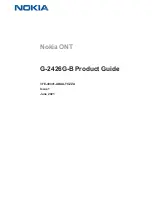
Single Point Setup
Channel Management
Cisco Small Business WAP371 Wireless Access Point Administration Guide
153
10
•
Band—The band on which the access point is broadcasting.
•
Channel—The radio channel on which this access point is currently broadcasting.
•
Locked—Forces the access point to remain on the current channel.
•
Status—Shows the status of the wireless radio in the device. (Some WAP devices may
have more than one wireless radio; each radio is displayed on a separate line in the
table.) The radio status is up (operational) or down (not operational).
When selected for an access point, automated channel management plans do not reassign the
WAP devices to a different channel as a part of the optimization strategy. Instead, WAP
devices with locked channels are factored in as requirements for the plan.
Click Save to update the locked setting. Locked devices show the same channel for the Current
Channel Assignments table and the Proposed Channel Assignments table. Locked devices
keep their current channels.
Proposed Channel Assignments Table
The Proposed Channel Assignments table shows the proposed channels that are to be assigned
to each WAP device when the next update occurs. Locked channels are not reassigned—the
optimization of channel distribution among devices takes into account that locked devices
must remain on their current channels. WAP devices that are not locked may be assigned to
different channels than they were previously using, depending on the results of the plan.
For each WAP device in the Single Point Setup, the Proposed Channel Assignments table
shows the location, IP Address, and Wireless Radio, as in the Current Channel Assignations
table. It also shows the Proposed Channel, which is the radio channel to which this WAP
device would be reassigned if the channel plan is applied.
Configuring Advanced Settings
The Advanced settings area enables you to customize and schedule the channel plan for the
Single Point Setup.
By default, channels are automatically reassigned once every hour, but only if interference can
be reduced by 25 percent or more. Channels are reassigned even if the network is busy. The
default settings are designed to satisfy most scenarios where you would need to implement
channel management.
You can change the Advanced settings to configure the following settings:
•
Change channels if interference is reduced by at least—The minimum percentage of
interference reduction a proposed plan must achieve in order to be applied. The default
is 75 percent. Use the drop-down menu to choose percentages ranging from 5 percent
to 75 percent. Using this setting lets you set a threshold gain in efficiency for channel
Содержание WAP371
Страница 13: ...Getting Started Window Navigation Cisco Small Business WAP371 Wireless Access Point Administration Guide 9 1 ...
Страница 52: ...Administration Support Information Cisco Small Business WAP371 Wireless Access Point Administration Guide 48 3 ...
Страница 60: ...LAN LLDP Cisco Small Business WAP371 Wireless Access Point Administration Guide 56 4 ...
Страница 99: ...Wireless Quality of Service Cisco Small Business WAP371 Wireless Access Point Administration Guide 95 5 ...
Страница 132: ...Simple Network Management Protocol Targets Cisco Small Business WAP371 Wireless Access Point Administration Guide 128 8 ...
Страница 161: ...Single Point Setup Wireless Neighborhood Cisco Small Business WAP371 Wireless Access Point Administration Guide 157 10 ...










































